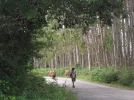Hello friends,
I walked the Camino Frances last year and am now preparing to walk the Camino del Norte in May. I've been checking out blogs and websites and also ordered the Spanish guide "Camino Norte de Santiago" by Anton Pombo (2010) which just arrived. On examining the maps today, I was surprised by just how much of the route is road-side walking and on asphalt (it looks like more than 50% of the way)!
I understand the views are spectacular on this route and the number of pilgrims few, but can anyone who has walked both the Frances and the Norte, give some comparison as to the surfaces of the trails and the overall environment you pass through. I felt that while there were many many pilgrims on the Frances, the trail itself was a very quiet way... through fields, sleepy towns and forrests. Is the North route through much more populated areas, and mostly along major roads?
Thank you so much for your feedback.
Cheers and Buen Camino
Liana
I walked the Camino Frances last year and am now preparing to walk the Camino del Norte in May. I've been checking out blogs and websites and also ordered the Spanish guide "Camino Norte de Santiago" by Anton Pombo (2010) which just arrived. On examining the maps today, I was surprised by just how much of the route is road-side walking and on asphalt (it looks like more than 50% of the way)!
I understand the views are spectacular on this route and the number of pilgrims few, but can anyone who has walked both the Frances and the Norte, give some comparison as to the surfaces of the trails and the overall environment you pass through. I felt that while there were many many pilgrims on the Frances, the trail itself was a very quiet way... through fields, sleepy towns and forrests. Is the North route through much more populated areas, and mostly along major roads?
Thank you so much for your feedback.
Cheers and Buen Camino
Liana




















